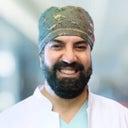Posted underHair Transplant q&a
Is it standard practice to put plastic over a hair transplant recipient area when the patient is leaving after the operation?
Is it standard practice to put plastic over a hair transplant recipient area when the patient is leaving after the operation? And also to recommend using the plastic saran wrap for the first week after the operation? Could doing this cause infection?
Answers (6)
From board-certified doctors and trusted medical professionals

Dr. Jae Pak, MD
Hair Restoration Surgeon, Board Certified in Emergency Medicine
Answer

Dr. Bernardino Arocha, MD, FISHRS
Board Certified Hair Restoration Surgeon
Answer
Dr. William Rassman, MD (retired)
Hair Restoration Surgeon, Board Certified in General Surgery
Answer
More Hair Transplant Questions
See all Hair Transplant Q&AWE SEND PRETTY
EMAILS
What’s trending? Who’s turning heads? Which TikTok myths need busting? We’ve got you. No fluff, no gatekeeping—just real talk. Get our free, unfiltered newsletter.

